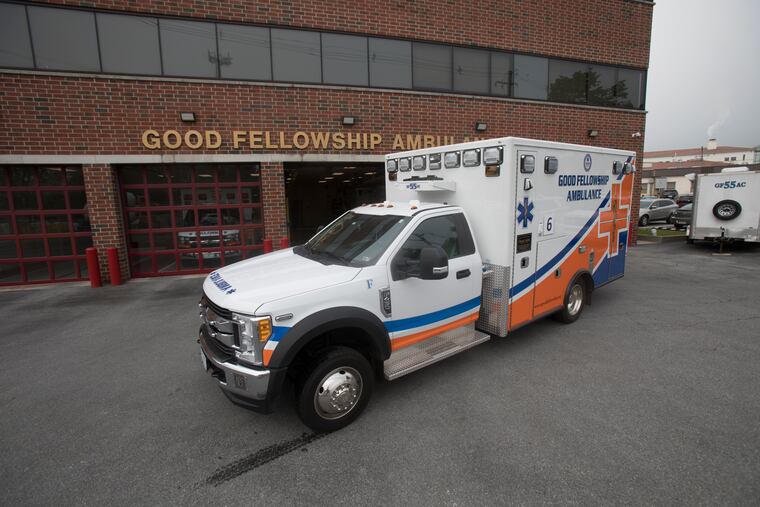How volunteer fire, ambulance companies are facing the coronavirus pandemic in Philly suburbs
In 2018, 1,258 EMS agencies statewide with 36,655 certified emergency medical technicians and paramedics responded to more than 2.1 million emergency calls.

The recent quarantine of 22 Montgomery County first responders sent a chill through many volunteer departments in the Philadelphia area, with a number of them already facing staffing shortages, increased volume of calls, and financial worries.
For years, volunteer fire and emergency medical services have warned of a potential crisis. Now these small departments are facing a pandemic with many unknowns.
Last week, an Upper Merion Township EMS provider tested positive for the coronavirus. The county also quarantined other fire and EMS personnel who had contact with the sick EMS worker. Officials do not know for certain how the first responder contracted the virus, but a few days earlier he was involved in transporting a coronavirus patient to Paoli Hospital. He is recovering at home, according to the township.
Since then, the township has been using part-timers and overtime to make up for staffing shortfalls, said Thomas Nolan, director of public safety. The hope is that the quarantined staff will soon be back at work, he said.
In Chester County, 22 people would be the entire roster of some of the smaller agencies, said Harry Moore, the county’s deputy director for emergency medical services. Many of those paramedics and emergency technicians work multiple jobs in different municipalities.
“A quarantine of a handful of providers has the potential to impact multiple agencies,” Moore said.
To try to contain any cross-contamination of staff, the county is sending out a daily briefing of best practices to departments and first responders that includes suggestions that they limit any training, ban unauthorized access to stations, and not eat or socialize together while in the station. Some departments are positioning units in different locations so crews don’t come into unnecessary contact with each other, he said.
If there were to be serious staff shortages that could not be handled locally, the county would look at all options including requesting help from the National Guard, Moore said.
» READ MORE: In Pa. suburbs, ambulance companies struggle to stay afloat
Emergency departments in Pennsylvania struggle with retention and recruitment for jobs where the pay ranges from $13 to $25 an hour.
In 2018, there were 1,258 EMS agencies statewide, with 36,655 certified emergency medical technicians and paramedics who responded to more than 2.1 million emergency calls. That same year saw a net drop of more than 1,300 certified workers from the year before, according to the state Bureau of Emergency Medical Services’ most recent report.
The problems EMS workers face are potentially to be exacerbated by the pandemic, said Dave Finger, chief of legislative and regulatory affairs with the National Volunteer Fire Council.
Even larger city departments may have staffing problems if there are multiple quarantines, he said.
“For most of your major disasters, like hurricanes and wildfires, you can go to a state that is not impacted and pull [help] from there,” said Finger. “If this becomes a national disaster, then where do you pull resources from? That becomes the challenge."
Slowing the spread of the virus with shutdowns and social distancing will put a lot less pressure on the emergency services workers and the hospitals, Finger said.
The limited number of paramedics and emergency medical technicians in the region has left many departments vying for the same people.
“A lot of our staffing works someplace else,” said Berwyn Fire Company EMS Capt. Michael Baskin. “If they get quarantined because of another full-time or part-time job, it will affect our staffing just as if we had the quarantine here.”
Normally, most companies focus on the care of their community. Now, with the pandemic, their ability to stay in service is an added worry, he said. The fire company has been working on contingency and staffing plans for weeks, he said.
“There is always going to be something in place from a 911 standpoint,” Baskin said. There are already procedures to find the next-closest EMS, fire, and police departments regardless of a pandemic, he said.
» READ MORE: Why the coronavirus and most other viruses have no cure
One good thing is that local agencies that are used to operating in their own silos are all talking more frequently.
“We are all coming together to see what we can do to assist each other from a regional perspective,” said Gary Vinnacombe, president of EMS Council for Chester County.
The situation is rapidly evolving, he said. Local agencies have ramped up planning as a response.
“We don’t know what the needs are going to be, so we are trying to anticipate a very broad spectrum of things,” Vinnacombe said.
They are also evaluating the staff members to make sure they take care of themselves, get proper rest and enough nourishment, and get downtime to help them stay healthy at work.
“They are the most important asset we have,” Vinnacombe said.